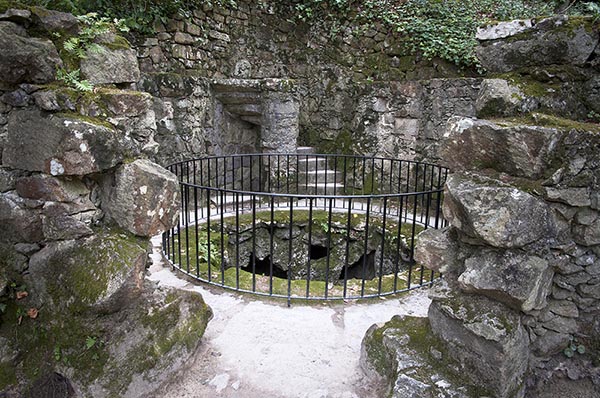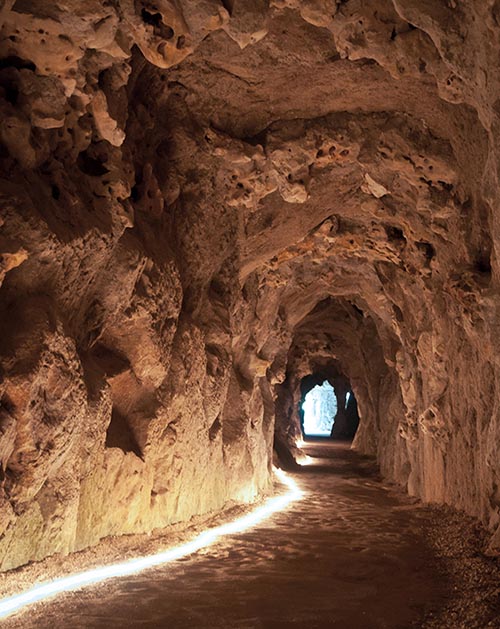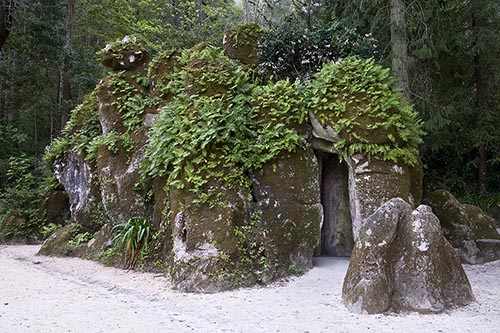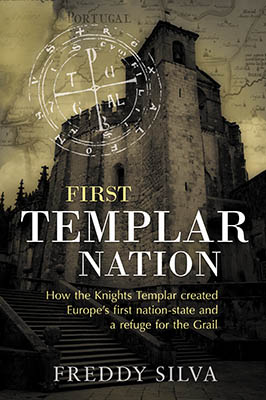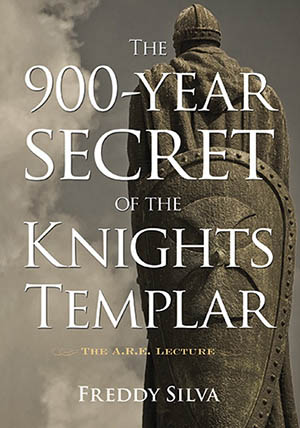Such chambers still exist below original Templar buildings in Sintra, Portugal, a town donated to Gualdino Paes — one of the five knights sent by Hugues de Payens to “establish a Portuguese crown” and who later became Templar Master of Portugal. The Templars’ properties in Sintra now serve modern day businesses, such as the Hotel Central and Café Paris. In 1970 a hypogeum or ritual chamber with access tunnels was discovered beneath said café, with a connecting passageway leading one way to the nearby Palace, and the other uphill towards the Templar castle.
Fifteen minutes’ walk from Sintra’s main square lies another property that right up to the Middle Ages was described as the Forest of Angels. Today it is the site of an extensive property owned by successive Masonic families dating to at least the early 18th century; in 1371 it was still in the possession of the Knights Templar. Its gardens can only be described as a deliberately designed ritual landscape. One of its many wonders is a labyrinth of tunnels penetrating deep into the bedrock of the mountainside, as though meant for initiates wishing to immerse themselves in the womb of the Earth Mother, much like Gnostic sects have done throughout history.
One tunnel leads to a shaft sunk forty feet into the earth. It is officially described as a well yet close examination shows it never did, nor is it capable of retaining water. It consists of five levels of unevenly stacked and undressed limestone blocks, here and there patched and repaired. Behind the blocks hide five low and narrow circular galleries, each accessed through claustrophobic spiral and in a style that suggests a later refurbishment. The top of the shaft is literally an eighteen-foot diameter hole, level with the ground and surrounded by a rough, dry-stone wall in the shape of a horseshoe. The entrance faces northeast and, like Stonehenge’s horseshoe of bluestones, it references the highest position of the light, the summer solstice sunrise, an esoteric reference to ancient wisdom and, coincidentally, the feast day of John the Baptist, to whom the Templars dedicated a disproportionate amount of churches in Portugal and elsewhere.
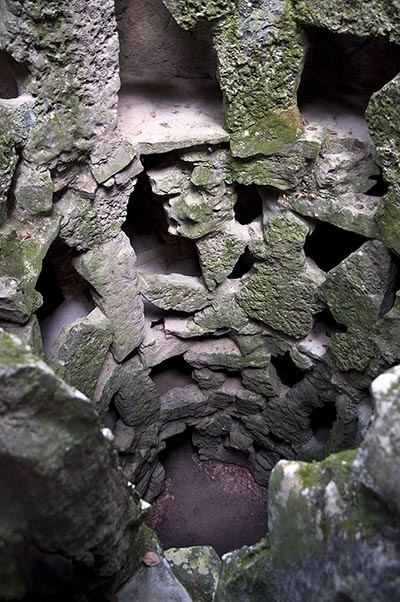
inside one of the initiation ‘wells'.
But by far the greatest evidence pointing to the Templars having followed mystical practices and rites of initiation of the Mysteries appears in the town of Tomar. And the manner in which they inherited this property is nothing short of extraordinary.
Once Afonso Henriques secured the Portuguese nation-state with Templar assistance, he awarded what amounted to a third of his territory to the brotherhood, who in turn made good use of it by creating a kingdom within a kingdom. Its center was Tamarah (as it was then spelled), named for the daughter of Jesus and Mary Magdalene. The name means ‘palm tree’, so it similarly represents the symbol of the resurrected Egyptian god Osiris. Before they set about rebuilding the town, the Templars undertook a near pathological interest in re-erecting a dilapidated church, Santa Maria do Olival, which later became ‘mother of all Templar churches’. Indeed, all twenty-two Portuguese Templar Masters would be buried in this unimposing edifice. Clearly Tomar was a focal point of the Templar empire and served some undisclosed purpose in a larger plan, for it was from here that their maritime empire grew after the Order’s supposed destruction in the 14th century; in Portugal the Templars simply changed their name and continued business as usual.
From the church’s crypt a tunnel branches off in two directions, one towards the main plaza of Tomar and its unusual church dedicated to John the Baptist. It’s passage is marked by a mysterious pyramidal stone relief of a dog (representing Sirius, the star associated with ancient knowledge) and a lion (representing Regulus, the bright star in Leo, referred to as the Royal Star and the gateway to the records of all knowledge). From there the tunnel veers uphill to what became the Templar’s most famous building, the rotunda.
Like the Abbey de Notre Dame du Mont Sion in Jerusalem, the rotunda stands prominently on a limestone hill overlooking the town. Around the periphery of the enigmatic building are symbols relating to esoteric practices, along with the emblem of the mysterious Ordre de Sion, the cross and rose. The rotunda is described as a church yet never did it have an altar. Or for that matter a door. Entry into the original building was via a tunnel beneath the floor. During one visit to the town’s archives I came across an account of restoration work conducted in the 1940s describing how the exterior of the rotunda had been coated with reinforced concrete that hid or destroyed the entrance to a crypt.
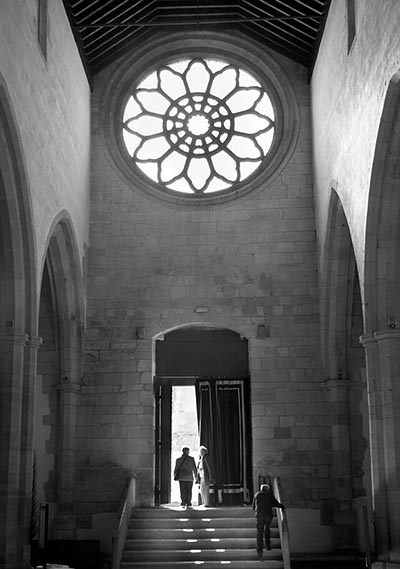
The Templar's mother church. Santa Maria do Olival.
It was then I came across an account of a stone mason who’d performed restoration work in the rotunda at the end of the 19th century. “It was the habit of one of these masters to return home and register the alterations made inside the castle, because these would continue until much of what was old would be made unrecognizable or made to disappear. One of the things that riled him the most was the disfiguration of the beautiful and intriguing Arab pathway that the old monks of the Temple used in their ceremonies and led directly to the basement of the Temple church [the rotunda].”
Even in those days the brothers living in the convent used to share stories with the masons of how Master Gualdino Paes brought back from the Holy Land the plans of the Holy Sepulcher that were to be used for the construction of the rotunda. Master Gualdino also ordered a pathway leading to it to be constructed in the Arabic style, and that both were used not just for secret religious ceremonies but also for the investiture of new knights. The monks also spoke of the Templar Master returning with many scrolls. He kept them safely in a room excavated out of the rock, which the monks referred to as the ‘gate to the underworld’. This doorway rested on very old stonework upon whose uprights the Templars carved dragons, and on the supported lintel, a kind of winged serpent.
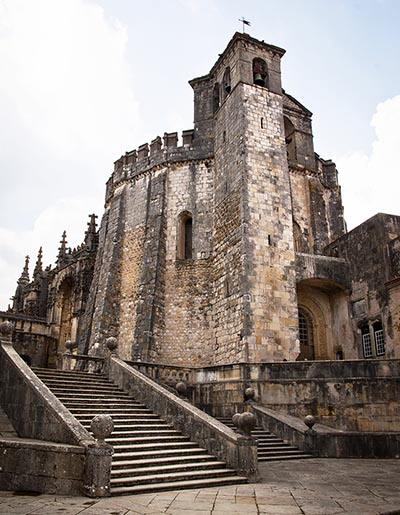
The rotunda of Tomar.
During recent attempts to beautify the perimeter of the castle of Tomar and its rotunda, an area was cleared around the original Almedina gate. Below it there is a doorway into a cave. The lintel stone is still in place, and indeed a kind of winged serpent is carved upon it, flanked by the heads of two dragons; a drawing made in 1918 shows the engravings still in their entirety, accompanied by a description of which parts of the Arab pathway were visible inside the subterranean passages leading to the chamber beneath the rotunda.
Continue to part IV
Return to Articles
Entrance to one of the Templar initiation 'wells' disguised as a neolithic dolmen. Sintra
